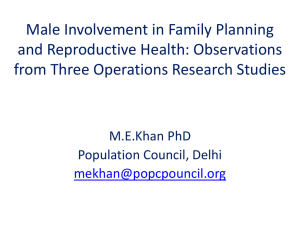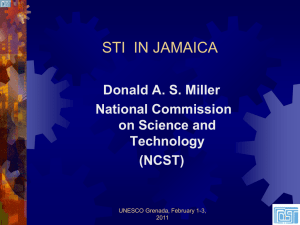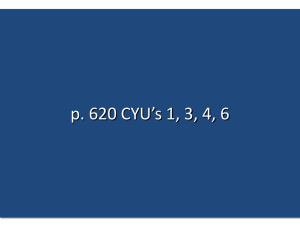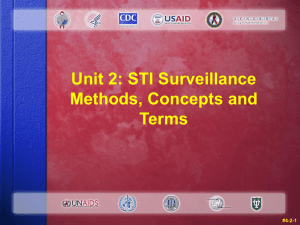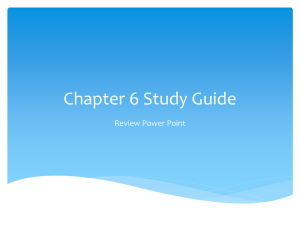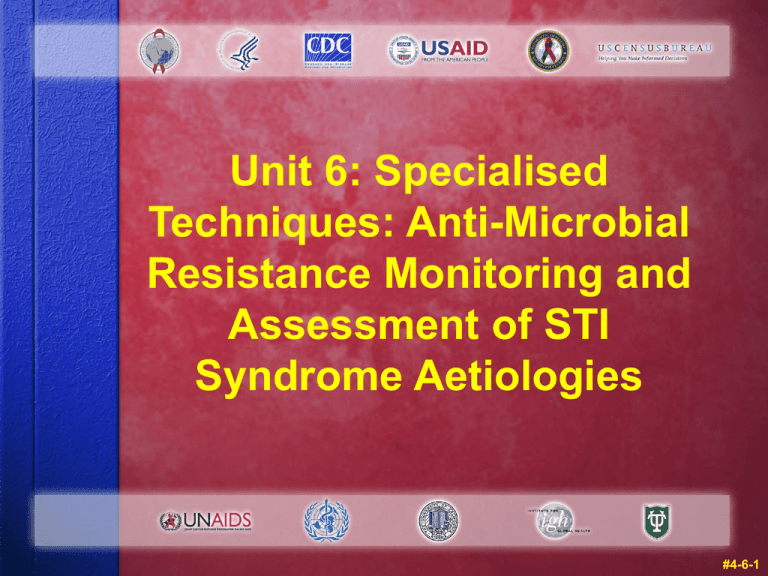
Unit 6: Specialised
Techniques: Anti-Microbial
Resistance Monitoring and
Assessment of STI
Syndrome Aetiologies
#4-6-1
Warm Up Questions: Instructions
Take five minutes now to try the Unit 6 warm
up questions in your manual.
Please do not compare answers with other
participants.
Your answers will not be collected or graded.
We will review your answers at the end of the
unit.
#4-6-2
What You Will Learn
By the end of this unit you should be able to:
discuss the objectives of anti-microbial resistance
monitoring in N. gonorrhoeae and H. ducreyi
discuss why assessment of syndrome aetiologies is a
core component of a comprehensive STI surveillance
system
describe the two main STI syndromes and their
microbiological causes
discuss how data from assessments of syndrome
aetiologies are used to revise syndromic treatment
guidelines
#4-6-3
Monitoring of Anti-Microbial
Resistance of STI Pathogens
Resistance is the alteration of a pathogen,
making it non-responsive to a particular drug.
Monitoring helps identify which groups are at
higher risk of infection with resistant strains
and helps to detect newly emerging
resistance.
Appropriate treatment can then be planned.
#4-6-4
Laboratory Requirements
Surveys are usually organised by the national
AIDS/STI control programme.
Choose sites with well-trained staff and
laboratory expertise.
Lab should be able to:
culture organism
perform serologic confirmatory tests
perform MIC agar dilution testing
If no national lab support is available, isolates
can be sent to another country for testing.
#4-6-5
Planning the Testing
Sample size depends on:
expected prevalence of disease in
population
whether sample will be used to monitor
trends over time
Possible types of sampling are:
random
systematic
consecutive
#4-6-6
Frequency of Assessment
At least once a year
Best to sample on an ongoing basis
Resistance can thus be detected early on
For example, test 20 isolates per month at
each sentinel site
#4-6-7
Data Analysis and Interpretation
Microbiologists familiar with test sensitivity
and specificity should interpret results.
If a change is noted, determine if it is due to:
real shifts in resistance patterns
problems in the laboratory
If shifts are noted, do the following to explore
the problem or resistance pattern:
expand sample
increase number of sites
#4-6-8
What Should be Done
with Resistance Data
Resistance should be reported immediately to
a WHO Collaborating Centre.
Resistance data should be used to update
treatment guidelines and revise the country
list of essential drugs.
#4-6-9
Figure 6.1. Frequency of
Tetracycline-Resistant
N. Gonorrhoeae, 1988-1993
Source: Van Dyck et al., Sex Transm Dis 1997
#4-6-10
Figure 6.2. Frequency of
Penicillinase-Producing
N. Gonorrhoeae, 1988-1993
Source: Van Dyck et al., Sex Transm Dis 1997
#4-6-11
Disseminating Results
Distribute results on resistance (similar to
Figures 6.1 and 6.2) at least annually.
This assists interpretation of test results for
patients whose previous therapies failed.
Information in report should include:
gender of patients
clinic setting where patients were tested
changes in sentinel sites over time
#4-6-12
Assessing STI Syndrome
Aetiologies
Involves determining which micro-organisms
cause urethral discharge and genital ulcer
disease
Especially important where syndromic case
reporting takes place
Should be conducted by the national
AIDS/STI control programme every 2-3 years
#4-6-13
Objectives of Assessing STI
Syndrome Aetiologies
Provide data for guiding STI syndromic
management
Assist in interpretation of syndromic case
reports and assessment of disease burden
due to specific pathogens
Design or modify guidelines for treating
urethral discharge and genital ulcers
#4-6-14
Laboratory Requirements
Microbiologist experienced in STI diagnostic tests
should develop national laboratory protocols.
Range of diagnostic tests is broad.
Choice depends on local availability of laboratory
resources.
See Table 6.1 in your manual for laboratory tests for
specific STI syndromes.
#4-6-15
Where to Conduct the
Assessments
Ideally, aetiology assessment should be
conducted in:
Different types of populations
Populations with high and low disease rates
Different locations
If your country has limited resources, conduct the
assessment in a single specialised STI clinic:
With well-trained staff that can perform Gram stains
and microscopy
With the ability to perform syphilis serologic testing
#4-6-16
Sample Size
Depends on:
Specific aetiology
Expected prevalence of pathogens
Minimum sample size of 50 or 100 specimens
from consecutive patients will provide
adequate information for useful analysis.
#4-6-17
Data Analysis
Analyse results for each disease separately.
Frequency of various STIs and risk
behaviours can then be analysed by:
Gender
Age group
Geographic area
Marital status
Other relevant characteristics
#4-6-18
In Summary
Anti-microbial resistance monitoring helps detect
emerging resistance and develop treatment
guidelines.
Assessing syndrome aetiologies provides information
on the relative contributions of different pathogens to
the main STI syndromes.
This guides STI syndromic treatment and assists in
the interpretation of syndromic case reports.
#4-6-19
Warm Up Review
Take a few minutes now to look back at your
answers to the warm up questions at the
beginning of the unit.
Make any changes you want to.
We will discuss the questions and answers in
a few minutes.
#4-6-20
Answers to Warm Up Questions,
Cont.
1. For countries where syndromic STI case
reporting is used, syndrome aetiologies
should be reassessed every ________ years.
a. one to two
b. two to three
c. three to four
#4-6-21
Answers to Warm Up Questions,
Cont.
1. For countries where syndromic STI case
reporting is used, syndrome aetiologies
should be reassessed every ________ years.
a. one to two
b. two to three
c. three to four
#4-6-22
Answers to Warm Up Questions,
Cont.
2. True or false? Monitoring anti-microbial
resistance of N. gonorrhoeae may help to
detect newly emerging resistance.
#4-6-23
Answers to Warm Up Questions,
Cont.
2. True or false? Monitoring anti-microbial
resistance of N. gonorrhoeae may help to
detect newly emerging resistance. True
#4-6-24
Answers to Warm Up Questions,
Cont.
3. Choose an item below that is not one of the
main purposes of assessing syndrome
aetiologies.
a. provide data for guiding STI syndromic
management
b. assess effectiveness of HIV prevention
programmes
c. assist in the interpretation of syndromic case
reports and the assessment of disease burden
caused by specific pathogens
d. evaluate syndromic management algorithms for
urethral discharge and genital ulcers
#4-6-25
Answers to Warm Up Questions,
Cont.
3. Choose an item below that is not one of the
main purposes of assessing syndrome
aetiologies.
a. provide data for guiding STI syndromic
management
b. assess effectiveness of HIV prevention
programmes
c. assist in the interpretation of syndromic case
reports and the assessment of disease burden
caused by specific pathogens
d. evaluate syndromic management algorithms for
urethral discharge and genital ulcers
#4-6-26
Answers to Warm Up Questions,
Cont.
4. List two possible uses of data obtained from
monitoring anti-microbial resistance of STI
pathogens.
#4-6-27
Answers to Warm Up Questions,
Cont.
4. List two possible uses of data obtained from
monitoring anti-microbial resistance of STI
pathogens. Obtain the data necessary for
developing and revising treatment guidelines;
detect newly emerging resistance
#4-6-28
Answers to Warm Up Questions,
Cont.
5. Which of the following sampling strategies is the
most difficult to use when conducting antimicrobial resistance monitoring?
a. random
b. systematic
c. consecutive
#4-6-29
Answers to Warm Up Questions,
Cont.
5. Which of the following sampling strategies is the
most difficult to use when conducting antimicrobial resistance monitoring?
a. random
b. systematic
c. consecutive
#4-6-30
Small Group Discussion:
Instructions
Get into small groups to discuss these
questions.
Choose a speaker for your group who will
report back to the class.
#4-6-31
Small Group Reports
Select one member from your group to
present your answers.
Discuss with the rest of the class.
#4-6-32
Case Study: Instructions
Try this case study individually.
We’ll discuss the answers in class.
#4-6-33
Case Study Review
Follow along as we go over the case study in
class.
Discuss your answers with the rest of the
class.
#4-6-34
Questions, Process Check
Do you have any questions on the information
we just covered?
Are you happy with how we worked on Unit 6?
Do you want to try something different that will
help the group?
#4-6-35

